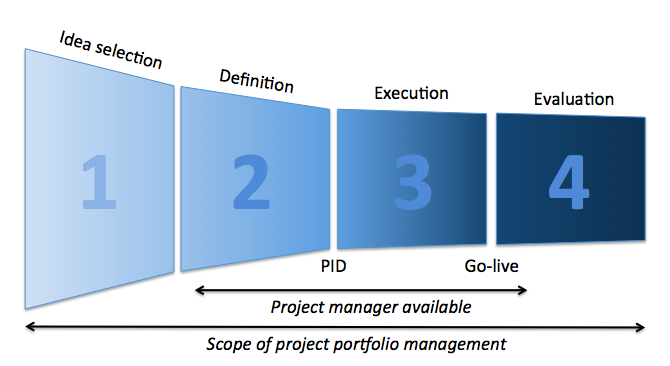Trends in project portfolio management
| Sieuwert van Otterloo |
Project Management

Modern companies have many different IT projects or change projects on-going at the same, and therefore have a need for project portfolio management. We asked portfolio management expert Paul Beelen from Improven on current trends and insights into how companies manage their project portfolio.
 Paul Beelen has advised several organisations, such as the Ministry of Economic Affairs, Rabobank, Tata Steel and Liberty Global about project portfolio management strategy and tools: “I started in PPM advising Rabobank about resource and project management, after this project I was asked as a consultant to help with PPM tool selection for the Dutch Ministry of Economic Affairs. Since then I have kept learning more and more about PPM, and shifted from only tooling to PPM strategy”.
Paul Beelen has advised several organisations, such as the Ministry of Economic Affairs, Rabobank, Tata Steel and Liberty Global about project portfolio management strategy and tools: “I started in PPM advising Rabobank about resource and project management, after this project I was asked as a consultant to help with PPM tool selection for the Dutch Ministry of Economic Affairs. Since then I have kept learning more and more about PPM, and shifted from only tooling to PPM strategy”.
Strategic alignment
The PPM goals of organisations shift depending on how far they are with PPM. The basic level of PPM is a matter of registration: organisations need to know how many projects they have, what the status and approved budget is for each project and who approved each project. Most large organisations have reached this maturity level, but many organisations that have grown fast in the past years need to make a next step at some point. On the higher maturity levels, PPM tools should also give insight into alignment with the company’s strategy. Companies do not just want a set of well-run but independent projects: they want to know that the projects selected are in line or aligned with the overall company strategy. Modern tools have developed new functions that help to do exactly this.
Project lifecycle and link with project management
Most project managers focus on the execution phase of projects: they manage a project from approval of the project execution plan until completion of the project (typically the go-live of changes to the IT system). The actual lifecycle of projects is much longer and the role of PPM is to manage this full lifecycle. Most tools use a simple project funnel, consisting of the following steps:
- Idea selection
- Definition
- Execution
- Evaluation
Projects move from idea selection to definition when the management decides to appoint someone to develop a project plan. A project moves from definition to execution when a project plan (or PID) is being approved. Once all technical milestones (typically: design, build and test) are achieved the project team is often re-assigned: this is the end of the execution phase. For IT-staff this is often the end of the project, but for the business users it is often the beginning. During the evaluation phase the value of the project should be realized: it is not evaluation of the IT milestones, but of the business goals such as more sales or cost savings (see also our previous post on organisation change). Project managers are often no longer around to manage this phase, so it is up to the central Project Management Office to keep track of the business results in this phase.
Agile portfolio management
Many organisations such as ING and Philips have adopted an agile way of working. The have scrum masters, product owners and self-guiding teams in addition to or even instead of project managers, and work with backlogs instead of fixed scope lists. This new way of working has many benefits for the teams itself, but means that project management offices need to change their ways of working. The first change is simple: shorter reports. In an agile environment one can make reports more often (the agile deliveries provide a lot of transparency) but these reports should be extremely short and to the point in order to be useful.
The PPM tools are adopting as well. Many tools allow project managers to define epics, so that they can measure progress in agile terms. The tools are also being redesigned to reduce the data input by project managers: instead of bureaucrats who spend their time reporting, project managers should be entrepreneurs who have freedom and creativity to resolve issues.
Role of the project steering committee
There is a lot of training available on how to manage projects. There is not as much training for the members of a project steering committee. As a result, many steering committees are not as effective as they could be. A common pattern is that steering committees become panels focused at detecting flaws and mistakes, and project managers become good at hiding the real issues and reporting green lights only. These all-green reports are not useful. Instead, project managers should bring actual data, share the real concerns and get support and advice on how to handle these concerns.
Pragmatic project management
The final trend that Paul sees is the need from organisations for more pragmatic project management. Although considered more and more a full-blown profession, project management is often not a full time role but an additional task given to internal staff. Organisations and projects are also increasingly international. This makes communication more complex. Organisation therefore need easy to understand and apply project management instructions and methods. Improven has responded by creating special ‘pragmatic’ project management trainings and workshops, that are less theoretical and more pragmatic than the traditional project management training. In theory, simpler tools and method give less insight in project portfolios. In practice these tools are used more often and fewer mistakes are made, leading to more insight.
Conclusion
Project portfolio management is an important function for large organisations and it is in transition. Organisations are shifting from basic registration to a more pragmatic, strategy driven and agile approach. Tools (such as Clarity, Changepoint and project online) are following these trends by improving their portfolio management offerings.
Image credit: condesign via Pixabay
Dr. Sieuwert van Otterloo is a court-certified IT expert with interests in agile, security, software research and IT-contracts.


